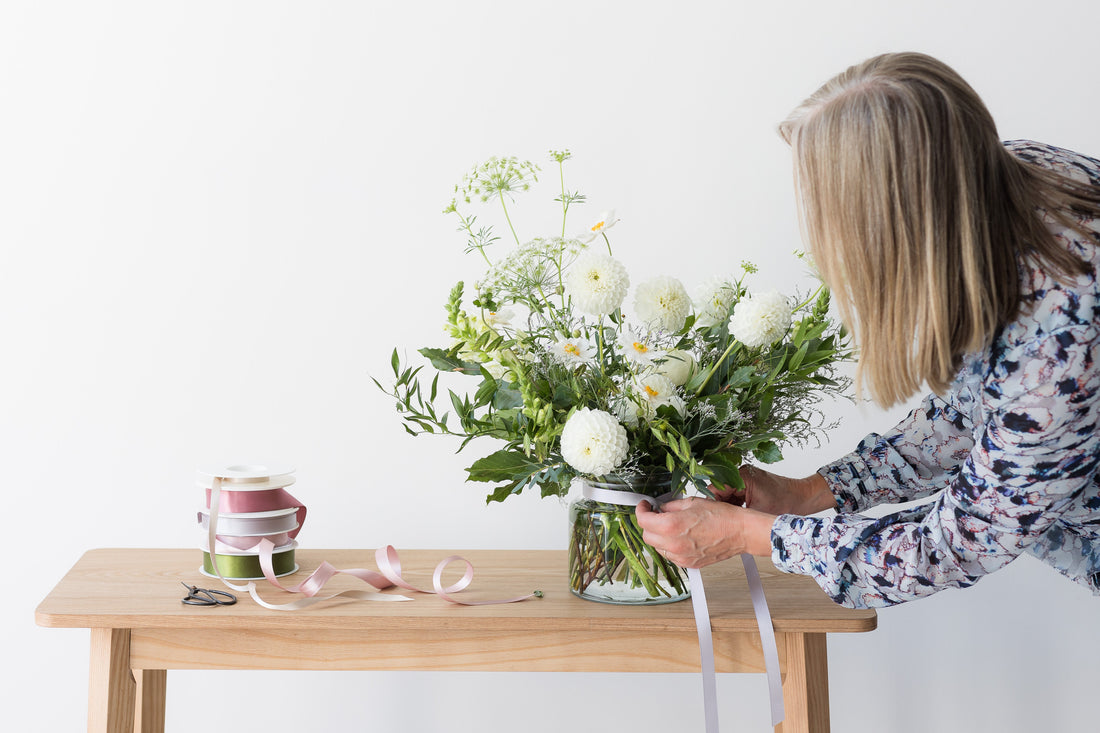
Farewell to flower food – why we’re ditching it
Share
Our florist, Frances, explains….
In the last couple of weeks our very last box of flower food ran out and we said goodbye and good riddance as the last sachet left the shop.
We’ve been including sachets of flower food along with all our bouquets and vases of flowers for years, but have actually been planning this farewell for some time now. And we know some of you may be wondering why.
Well, it’s simple: it’s the next step in our efforts to lessen our impact as a business on this beautiful planet.
It comes down to maths and chemistry. (Bear with me, if those two subjects scared you as much as they did me in school! It’s pretty straight-forward.)

Let’s start with the maths
As a small Edinburgh flower shop, we would distribute approximately 4,000 sachets of flower food each year. That’s 4,000 bits of plastic going out into the world. Add to that, a lot of people don’t even use the food – it’s simply tossed into the bin to make its way to landfill.
And that’s if it even makes it to the landfill – hands up who’s seen one such sachet on the ground as you’re walking somewhere? I certainly have.
In the past, we have even tried using paper or biodegradable sachets, but their shelf life in a shop with high humidity and water in use everywhere meant they were completely impractical.
So, back to the maths, that 4,000 is just from one small florist. Now multiply that by all the other florists who distribute flower food and add that to the huge amounts each supermarket distributes and that’s how many bits of plastic going to landfill?
A lot.
The mind boggles.
To adapt a meme I saw recently: ‘But it’s just one little sachet of flower food,’ said 8 million people.
And then there’s the chemistry
You may be thinking now, ‘But I need the flower food to ensure the flowers last longer and my money hasn’t been wasted’. That’s a fair thought, but let’s look at what’s actually in flower food: bleach, citric acid and sugar.
Essentially, the only ‘food’ part is the sugar, which doesn’t actually help that much, while the bleach and citric acid keep the water ‘cleaner’ for longer.
Here’s where we ask: why not just change the water and clean the vase regularly?
We wanted to make sure we really knew what we were talking about, so we decided to experiment. (Please picture us in white coats, with goggles and clipboards.) We took a bunch of flowers and put some in a vase with flower food and some in a vase with just fresh water. We cleaned the latter regularly and refilled with fresh water.
In all seriousness, chemists’ coats aside, we have conducted this same experiment several times over the years and always had the same result. Time and time again: the flowers lasted just as long in the vase without the flower food.
Thus, our ‘scientific’ conclusion is that flower food is not necessary and nothing beats fresh, clean water.

An obvious choice
It was an obvious decision, ultimately. Why on this green earth would we send thousands and thousands of bits of plastic to landfill? Or waste valuable resources by throwing away biodegradable versions?
Our beautiful planet does not need any more plastic, and this is another way for us to reduce our impact.
Read more about what we’re doing to work more sustainably here.
Read our advice and tips on flower care here.
If you’d like some floral inspiration, then do have a peek at our selection of beautiful bouquets and vases of flowers, created using the best seasonal flowers available and as sustainably as possible.

